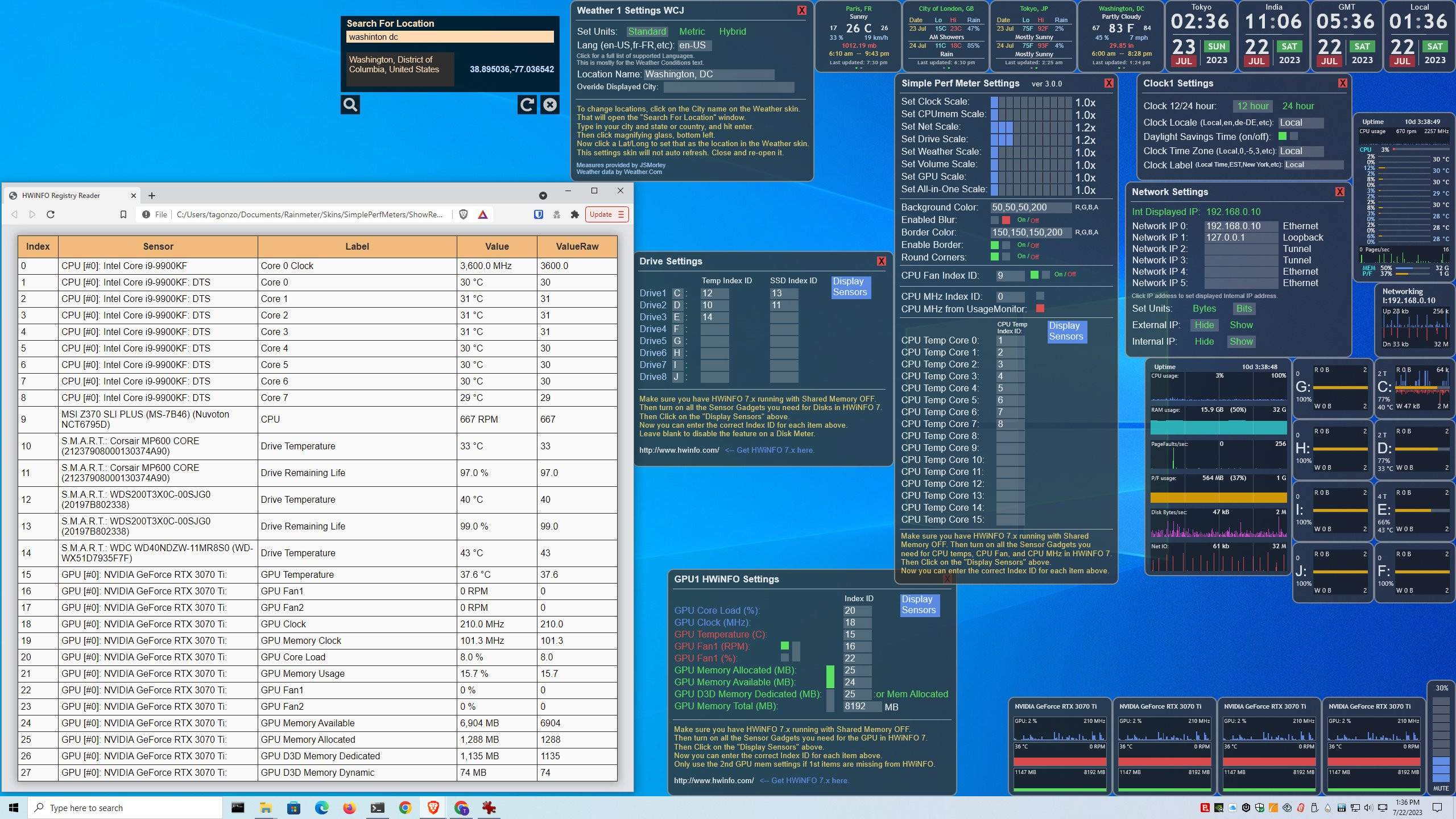HOME | DD
 TGonZ0 — SimplePerfMeters 3.0.2
TGonZ0 — SimplePerfMeters 3.0.2

Published: 2015-07-12 21:46:18 +0000 UTC; Views: 260691; Favourites: 448; Downloads: 48978
Redirect to original
Description
UPDATE 3.0.2 - 2024-05-23:Weather skin stopped working. Updated the API key, as the previous one expired.
Changed the GPU label so it is displayed right away.
UPDATE 3.0.1 - 2023-07-24:
Bug fix. CPU freq on CPUmem skin would move when scaled up. Now fixed.
UPDATE 3.0.0 - 2023-07-22:
I decided to update the major rev on this one because I have made a lot of changes. I'll list the changes first, then I'll lay out all the meters functions.
- Updated CPUmem to auto adjust up to 64 threads
- Changed all the deprecated PerfMon measure to use UsageMonitor. No more PerfMon plugin measures used.
- Changed all of the HWiNFO plugin measures to use the non-plugin Registry method with HWiNFO 7.x. (thank you raiguard, JSMorley, SilverAzide, and others for the ShowReg script to display the sensor Indexes.
- Changed the Weather skins to use JSMorley's WeatherComJSON measures, and added up to 4 Weather skins, and added a two day forecast panel. There are several tooltips on these, so move your mouse around and see what is there.
- Added SSD life to the Drive meters. Requires HWiNFO.
- Added rounded corners, which you can turn on or off.
- Added a border line, which you can change the color and turn on or off.
- Added Blur option, can be turned on or off.
- Can now hide both External and Internal IP addresses.
- Lots of clean up and standardization in my coding. Not perfect, but way better.
To use the new HWiNFO 7.x sensors (without the plugin), you need to get and run HWiNFO 7.x and make sure the Shared Memory settings is OFF. Then you need to go into the Settings, then HWiNFO Gadget tab, and turn on (enable Report value in Gadget) for each sensor you will use. FYI, indexes may change value if you add more sensors later.
On CPU temperatures. With Intel making the latest processors with Performance cores and Efficiency cores, I know the Temperature sensors do not line up with cores exactly in my meters. I think the Performance Cores are actually 2 threads and have just one temp sensor per 2 core(or two threads). Where the Efficiency cores are not threaded and have one temp sensor per core. With many different models of this Processor having different P to E core layouts, I'm not sure how I want to tackle that problem. So the CPUmem skins stay the same as they were for now. You can always use the CPUmem skin with just one temp sensor and use the HWiNFO sensor that represents the whole CPU.
----------------------------------------------------------------------
These are Simple Performance monitoring meters (and a couple of extras) that I wanted for my own use. They are simple looking but provide enough information so I can see if my system is running normally. This became way bigger that I thought it would, but they are all useful. I'll fix any bugs as best I can, and I am trying to slow down on changes to this skin.
There are several clickable locations on the meters. Clicking on any Histogram will start up the Performance Resource monitor. The idea is, you see a meter with high activity, click it to get quick access to the Resource monitor so you can investigate why it is happening.
There are 4 variants of the CPUmem Meter. The original no Temps, and 3 with Temp versions.
CPUmem.ini - the original meter with no Temps, no CPU fan.
CPUmemTemp1.ini - only displays 1 Temp, if you don't want to see every core. CPU fan rpm. Requires HWiNFO.
CPUmemTemp1nocores.ini - only displays 1 Temp, and no individual cores, only the Average CPU usage.
CPUmemTemp1to1.ini - This is more for AMD processors that have 1 core per Temp sensor. CPU fan rpm. Requires HWiNFO.
CPUmemTemp2to1.ini - This is for most Intel processors that have 2 threads per Temp sensor. CPU fan rpm. Requires HWiNFO.
All-in-One meter. I added this mostly for troubleshooting to save 4 minutes of data while I am using full screen programs. Some may choose to use this instead of some of the other meters. I only run this one when I want to see the last 4 minutes of data all in sync. There are 1 minute time lines to help show when the data spike occurred.
GPU meter added. Requires HWiNFO 7.x to be running, and sensors to be enabled for the GPU. Use the GPU settings to fill in the appropriate Indexes to get it working. Not all GPU drivers have all of the settings. So you will need to look at the Display Sensors button and find what you have available and fill them in. Integrated GPUs do not always have all the fields needed.
I did my best to make Settings skins so you would not have to edit any settings files by hand. You can still do that if you like, but the Settings skins should be enough to make it all work.
Any issues getting HWiNFO to run on your system, please visit the HWiNFO site and check their forums for help. www.hwinfo.com/
All in One
- click * in upper right corner to open the Settings to change scale of meters, now auto-hides
- All meters display 4 minutes of data, with 1 minute marker lines
- Uptime
- CPU Usage
- RAM usage
- PageFaults/sec
- PageFile usage
- Disk Bytes/sec (Read and Write combine), currently C: only
- Net IO (In and Out combine) Bits or Bytes follows the Network meter settings
- scalable size
- click * in upper right corner to open the Settings to change scale of meters
- Histogram of average CPU usage
- tooltip of CPU model when mouse over "CPU usage" string
- Bars of average CPU and per thread CPU usage
- CPU temperatures, 4 variants (no temps, only 1 core, 1 core per temp, 2 threads per temp) (req HWiNFO)
- CPU speed in MHz, choose from UsageMonitor or from HWiNFO
- ToolTip on CPU speed will display the Max speed of the CPU, which may not include the turbo or boost speeds
- CPU fan rpm, from HWiNFO, on variants with CPU temps
- click CPU/TASK to start the Task Manager
- click RAM/SYS to open the Control Panel -> System information page
- click P/F to open the window where you can change your Page File
- the CPU bar meters will automatically show only the number of CPUs you have up to 64 threads
- Memory size and usage, tooltip to show available mem
- Pages/sec is when memory allocation went to disk, which slows the system
- P/F Page File size and usage
- scalable size
Simple Perf Meter Settings
- click X in upper right corner to close
- click the bar to change the scaling factor from 1x to 2x in size
- set Background Color for all meters
- set Background Blur on or off
- Enable a Border on or off
- turn on Rounded Corners on or off
- CPU fan Sensor IDs from HWiNFO, with display on/off switch
- CPU Mhz Sensor IDs, choose from HWiNFO or from UsageMonitor, red block = selected
- Sensor ID input for the Temperature readings from HWiNFO, click on Display Sensor to see Indexes
Network Meter
- click * in upper right corner to open the Network Settings, use this if your Internal IP display is not correct
- click Ext IP address to open the Network and Sharing Center
- Network Upload/Download graphs in Bits or Bytes
- scalable size
Network Settings
- click X in upper right corner to open to close
- Can hide both External and Internal IP addresses. Nice when screen sharing.
- this will show up to 6 network interfaces and the IP address assigned to them
- click the IP address to set that as the displayed Internal IP
- Selectable Bits or Bytes
Disk Meter
- click the Drive Letter to open a Windows Explorer to that drive, tooltip shows drive make/model
- click the drive size to open the Restore Point configuration, tooltip for SSD life here if configured
- click Percent Used number to open the Disk Cleanup utility to that drive, tooltip shows available space
- the Center Yellow bar is also space used
- Read/Write graphs in Bytes
- Drive temperature from HWiNFO, can be turned on/off in the Disk settings
- scalable size
Disk Settings
- click X in upper right corner to close
- Type in any drive letter for each of the 8 disks
- Enter the correct HWiNFO index for each drive Temperature and SSD life if available
Clock Meter
- click * in upper right corner to open the Clock Settings, auto-hides
- You can now have 4 clocks running in different TimeZones
- Time on top, with seconds as a thin bar just below the time
- click Time to open the Windows clock settings
- click Month to open a browser link to the current Month
- click Year to open a browser link to the current Year
- in 12 hour mode, the : will be bright for AM, and dim for PM
- added Locale for Month and Day of Week, change in settings, "Local" will use your Windows Locale
- scalable size
Clock Settings
- click X in upper right corner to close
- Up to 4 clocks can be displayed
- Each clock has it's own settings
- TimeZone is only set by number offset from GMT, 0, -5, -9, 5.5, etc (sorry, that is how Rainmeter allows this)
- If the TimeZone is set to Local, it will use your computers TimeZone and DST settings.
- Label is only displayed (at the top) if you type something, anything you like, city, timezone, etc.
- DST Daylight Savings Time on/off
- Select 12 hour or 24 hour
- Locale setting, Local, en-US, de-DE, fr-FR, it-IT, es-ES, etc. It changes the Month and Day of Week.
Volume Meter
- click the volume percent number at the top to open Windows sound settings
- click anywhere on the volume bar to set volume
- scroll wheel also changes volume
- click mute to toggle mute
- scalable size
Weather Meter
- click * in upper right corner to open the Weather Settings, auto-hides
- City, State or Country (click this to open the Location Selector)
- Current conditions, tooltip with longer conditions narrative
- Temps, forecasted Low, Current temp, forecasted High (click the current Temp to open Weather.com to configured City)
- Humidity and Wind
- Atmospheric Pressure
- Sun rise and Sun set
- Click 2 dots at bottom to change to the Forecast panel
- Up to 4 Weather meters
- data is from weather.com
- scalable size
Weather Meter Forecast
- click * in upper right corner to open the Weather Settings, auto-hides
- City, State or Country (click this to open the Location Selector)
- Date, Low temp, High temp, Rain chance
- Forecasted conditions, tooltip for a longer conditions narrative
- Click 2 dots at bottom to change back to Current Weather panel
Weather Meter Location Selector
- Provided by raiguard and JSMorley
- type in City State or County, hit enter
- click search magnifier at bottom
- click on the city name to open in google maps to verify location is what you want
- click Lat, Long to set as the Weather meter location
Weather Meter Settings
- Standard / Metric / Hybrid (mostly for the UK)
- Locale setting, en-US, de-DE, fr-FR, it-IT, es-ES, etc. It changes a couple of fields from the data stream.
- Location name from the Location Selector skin
- If the name is not what you would like from the Selector, you can override the displayed name
GPU Meter
- Requires HWiNFO running
- Up to 4 GPU meters
- Display Graphics card model
- GPU load and graph, also has Core Clock speed
- GPU temperature and graph, also has Fan speed in rpm or % of operation
- Temp graph is 0-100 C
- GPU memory used and graph, and displays the total memory on the card
GPU Settings
- HWiNFO needs to be installed and running first
- click on the Display Sensors button to see the Indexes to use.
- Fill in the sensor Index information
- Pick if you want Fan rpm or % of Fan operation to be displayed, or turn it off
- If HWiNFO has the info needed for the 1st GPU memory data, use it before the 2nd method.
On all Histogram meters, the number on the left is the current sample and the number on the right is the scale of the Histogram.
Internal IP address. It seems the plugin that gets the Internal IP address works well most of the time. If it does not, you can choose the IP from a list that your system currently has configured in the Network Settings.
Background color. I set the default to black and is mostly transparent. (50,50,50,200) That way some color from your wallpaper would show through. If you have a very light or very dark wallpaper, and want a more solid color similar to the blue in my cover image, try using 0,50,100,240. That works good with all the other colors I used in the skins.
FYI, I made these on my Windows 10 system, and have tested it on Windows 11. Should still work on Windows 7 for those couple of people still running it. Requires Rainmeter 4.2 or newer.
Enjoy.
Related content
Comments: 125

Any idea why the GPU meter wouldn't be working? Can't get CPU temps either. Running Win10 64, everything as administrator. Tried refreshing, rebooting, etc. Shared Memory Support is enabled. I have a 970 like you do, with very similar values.
But I have to say everything looks nice!
👍: 0 ⏩: 1

Hi, The GPU meter and CPU temps requires that you download the HWiNFO program from hwinfo.com and have it running.
Then you need to run the HWiNFO Shared Memory Viewer, that is supplied with the Skin I made, click the icon in the Setting skin.
You need to change the Sensor IDs in the Settings skins to match what your system has in the HWiNFO Shared Memory Viewer.
Then the meters should work. The GPU and CPU temps use a plugin to communicate with the HWiNFO program to get that data.
If you do not have HWiNFO running, and configured with the correct Sensor IDs, then it those will not work.
If you have problems with HWiNFO, please go to the HWiNFO web site and check with their forums for help.
Hope that helps.
👍: 0 ⏩: 1

Also, if you do have HWiNFO installed and running, but it is still not working, I did have one of my computers where I had to manually copy the HWiNFO plugin dll to the Rainmeter plugin folder, to get it to work. All my other computers I did not have to do this. I still don't know why the one computer was different.
Copy
.....\Documents\Rainmeter\Skins\SimplePerfMeters\resources \RedistrutablePlugin\64-bit\HWiNFO.dll
to
C:\Program Files\Rainmeter\Plugins\HWiNFO.dll
Assuming a 64-bit Windows here.
Then refresh the skin.
On this issue, I did have HWiNFO installed but it would not work, and I saw an error in the Rainmeter About on the Log tab.
It said the HWiNFO.dll was not loaded.
The above dll copy fixed it.
👍: 0 ⏩: 0

Really nice work, mate. Is there any chance you could include CPU Temps?
👍: 0 ⏩: 1

Thanks, I appreciate that. I have thought about CPU temps. Everything I've done so far uses basic Rainmeter functions that are included. Adding CPU temps will require a 3rd party program or plugin. I see several people using HWiNFO lately to get extra info. I am looking into that and if it works out without making things too complicated, I'll probably add that.
👍: 0 ⏩: 1

Sounds great. Maybe add it as an extra ini or optional Variant. That way people aren't forced to use it. But as you said, since many people are using thrid party programs anyway, it would be nice to have. It's too bad Rainmeter doesn't support these things on its own though.
👍: 0 ⏩: 0

Back again. I recently noticed a slight bug in the network meter. Instead of my actual internal IP address (192.168.1.xx), it always displays (127.0.0.1). The closest solution I found was here: github.com/Kaelri/Enigma/issue… but I see no "Network.inc" file to try and fix myself.
I don't know. My knowledge of Rainmeter is limited, so I figured I would just report this to you.
👍: 0 ⏩: 1

Interesting. I did some looking into the SysInfo plugin that gets the IP in Rainmeter, and it looks like it can use any of the network interfaces that Windows has, and can be set with the SysInfoData= option to get a specific network port. The 127 is an internal virtual network that most all computers have. I've run this on 6 computers I own, and everyone showed the local internal IP correctly. I did a test on one system where I unplugged the network cable, and it displayed 127.0.0.1, then plugged it back in and it went back to 192.168.0.x IP.
I would say, check that first. If your network is available and working, then the SysInfoData= option will likely be needed on your system.
If so, I can make a Network Settings to simplify the setup of choosing the correct SysInfoData for the Network IP address.
But if you would like to try it out yourself, right click the Network meter and choose Edit skin. It should load into Notepad.
Go to the [measureIPaddressInt] section, and added the SysInfoData= and try different numbers, 0, 1, 2, 3. See if you get the 192.168.x.x number of your internal IP. Here is the section you would add that line to.
[measureIPaddressInt]
Measure= Plugin
Plugin=SysInfo
SysInfoType=IP_ADDRESS
UpdateDivider=14400
SysInfoData=1
Save the file, then Right click the Network meter and hit Refresh skin.
Try numbers 0,1,2,3,4. That should be enough testing. Hopefully one will work for you.
Let me know what happens.
👍: 0 ⏩: 1

"1" worked for me, thanks a bunch. Forgot to mention, I am running Windows 10 with a connected USB wireless antennae, if that is any helpful info.
👍: 0 ⏩: 1

I'm glad that option worked for you. Also, thanks for letting me know it is working well in Windows 10. I have made all this on my Windows 7 system, and I have an old XP box I test on as well. No Windows 10, yet. So, thanks for that.
Thanks for making that change and letting me know it worked. Because of that, I've added a simple Network Settings skin to make it easier to set the correct Internal IP. No more editing the files.
On all my systems, the internal IP was in the 0 position. Maybe Windows adds the USB network adapter after the others. Whatever the reason, I'm sure there are a few others out there that saw the same as you. So now you all have an easier way to correct it.
👍: 0 ⏩: 0

Very awesome skin. I am surprised this is not in the featured folder since it is quite simple and elegant. I wish there was a GPU meter, but I guess that seems a bit of a problem for any Rainmaker skin. I guess the only real criticism I can give here is that there is no option for a 12-hour clock format.
👍: 0 ⏩: 1

Thanks for the compliments. I've added 12/24 hour setting for the Clock. In 12 hour mode, the : will be bright for AM, and dim for PM. Enjoy.
👍: 0 ⏩: 1

Hi, I'm new using Rainmeter, how can I add this skin?
👍: 0 ⏩: 1

Hi, glad you are interested in my creation. I'll start from square one.
First you get Rainmeter program and install it. rainmeter.net/
Then you download my skin, download button should be above on the right.
Double click the skin file and it should load itself into Rainmeter and start the CPUmem skin.
There are a couple of ways to start up the other skins.
1. Right click the CPUmem skin and use the menu SimplePerfMeters, and you can start the skins you would like.
2. Or Click the Rainmeter icon in the system tray. Open the SimplePerfMeters folder, and then open the skin you want to load and click the ini file to start the skin.
Rainmeter also has it's own forum at rainmeter.net/ with lots of good info. It's worth checking out.
Hope that helps.
👍: 0 ⏩: 0

Nice job! Simple and easy to read, especially with the scaling feature you added. Would like to maybe see the weather window a part of the scaling feature if possible as it's a tad small to read on a 1920x1200 screen
👍: 0 ⏩: 1

Thanks, glad you like it. Now that I know how to do scaling, it should not take to much to add the Weather skin. Check back soon.
👍: 0 ⏩: 1

Ah cool, will do! Also it's working great on Windows 10 for me. Dunno if it matters or not but figured I'd let you know which version of Windows I am on heh.
👍: 0 ⏩: 1

I've already updated it. Weather now scales. Check it out.
👍: 0 ⏩: 1

Done and done! Works great, thanks a bunch!
👍: 0 ⏩: 0

Great job,thx for the share TGonZo
Maybe can we change the resolution of your skin,so little on my desk(1920/1080)
and thanks again
👍: 0 ⏩: 2

Okay, I've added change size settings for Clock, CPUmem, Network, and Disks. I hope that works for you.
👍: 0 ⏩: 0

Thanks, I'm glad you like it, and hope you find it useful. I have had another ask about making them larger. I am still fairly new to Rainmeter (couple of months), and it seems like there is not an easy way to just scale the whole skin up a bit. I will look into it, and will update if I find a way that does not require me to re-layout every skin to a new size.
👍: 0 ⏩: 0
<= Prev |




















